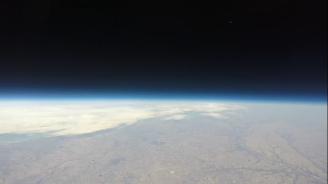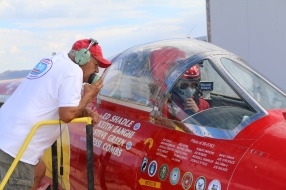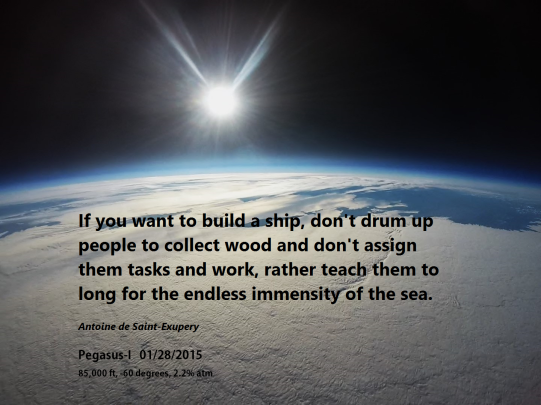The Pegasus Mission’s involvement with North American Eagle (NAE) started with the idea that Pegasus team could provide a real-time view into what was occurring with the vehicle to a global audience. This would be done by placing a device inside the cockpit of the Eagle. The hope was that we could transmit telemetry and receive user messages, i.e., bidirectional communications, from around the world over a 10.5-mile course in a remote location, no electricity or reliable cellular communications. We would do this is milliseconds, not seconds, without staging data or any polling, using our advanced experimental operational technology, Piraeus.
The reason this challenge is important, it is something that commercial environments experience, and is difficult at low latency. Companies engaged in natural resources generally are operating in remote locations and getting granular information into and out of these locations is certainly a challenge in just a few milliseconds. NAE not only provides this environment, it provides the opportunity to interface with global audience to test such a system a scale. Pegasus can take a challenging set of commercial circumstances and turn it into a participating and fun experience for the audience with NAE. The audience becomes part of the experiment, i.e., experiential research.
Here’s the catch…it is not possible with “stock” technology, and nobody has ever tried what we were about to do, especially at 400+ mph in a remote desert. We believed it was possible, but you must do it to find out and learn from it.
NAE team of about 40 dedicated souls on an ongoing mission to break the world land speed record. They are challenging a ~20-year record set by Andy Green, and doing it on shoestring budget. NAE is the place where STEM meets human experience to achieve the impossible. The NAE team must continually leverage their resourcefulness and constantly innovate to get the vehicle optimized for speed and cooperate with the pilot. The NAE’s effort is nothing short of heroic. It is with dogged determination that team manages a complex world of mechanics and engineering to perform a set of tasks seldom, if ever, experienced. Pilots, Ed Shadle and Jessi Combs, use their unique pilot/driver skills to operate the Eagle at extreme speed. Their skills are a glorious trifecta of athlete, engineer, and steely astronaut.
The meeting of the minds between NAE and Pegasus Mission intersects in that both teams are trying to challenge assumptions about what is possible. There is no guarantee of success, except lessons will be learned and used in the future for improvements. The secret is having the WILL to try at this at the intersection of STEM and the limits of human capability. We are locked together by some ethereal compelling force that overcomes the fear of failure with need to try.
When a phone app or Web site lights up with the real-time telemetry, it is an exciting experience during one of the NAE runs. However, what remains hidden is the difficulty and logistics of execution, which is Herculean. The NAE must transport an incredible amount of materials to the site over an 11-hour journey as well as the massive vehicle. It takes days to setup and requires 40-person team to accomplish. The Alvord Desert is devoid of everything from spare parts, fuel, generators, rest rooms, sleeping quarters, food, and water. If you do not bring it with you, it is not available.
The Pegasus logistics are not as massive, but considerable. We carry a 507 lbs. satellite communications network and another 200-300 lbs. of equipment over 180-miles across the mountains only to be faced with a 32-mile journey on an unpaved road across jagged volcanic rocks to get to the site. Once present, we face a 260-mile commute and restocking provisions daily. This is the price of admission to attempt to meet the challenge.
Once operationalized for runs, i.e., 2-days for NAE, Ed Shadle must attempt a test run to determine the operating condition of the Eagle and its behavior on the desert floor. This a critical test and gives the entire team the opportunity to check-down procedures and equipment. The Pegasus Mission must determine whether our device, field gateway, local network, SATCOM, and applications are performing as expected. The first 2 runs where short and Ed Shadle aborted due to steering issues. This means the engineers and mechanics of the NAE must kick into high-gear to solve the problem before time runs out…the clock was ticking.
The steering issue involves the pilot’s stick commands being responsive to the steering box of the Eagle. A decision was made to try and deliver parts delivered via a daring night flight from the Tacoma, WA area to the desert floor at Alvord. The NAE team would put up flares to define a runaway and have well lighted truck to designate the beginning of the makeshift runway for the pilot. Pilot, John Richardson, sign up for the attempt to deliver the parts to the desert floor with 4500 foot mountains surrounding the area in total darkness.
The NAE team spotted a plane around midnight, but it did not respond to signal flares. It was John, and he was concentrating on dodging mountains. He missed the signals and proceeded further south. Unfortunately, John mistakenly took a well-lite cattle truck as the runway marker and began a very slow descent into the abyss of the darkness. The plane touched down in a field and immediately ripped off the nose gear. The plane then stuck a fence, ripping out about 200 feet of it. The plane was destroyed, but John was unharmed and alone in the darkness near his plane.
The NAE team kicked into rescue mode and began to decipher John’s location. Through a serious of odds events that entailed coincidence and providence, the NAE team determined his approximate location and rushed into action. Several hours later John was at the base camp unharmed. His first words after being rescued, “I got your parts.”
The morning began we a flat tire during our commute to base camp. The NAE team was making corrections to the steering to prepare Ed for another test run. This time in the late afternoon. It worked reaching 362 mph and traveling approx. 10 miles. The Pegasus device maintained contact and we could stream telemetry and receive user messages into the cockpit from the global audience in real-time. Our only issue was the desert heat was killing the GoPro cameras in the cockpit.
The Pegasus team was excited with the anticipation of our functioning system for the next day’s runs. Jessi Combs would be the pilot and attempt to break the women’s land speed record. We began the commute out of base camp only to get another flat tire on a different vehicle (same road). A vehicle appeared out the darkness from behind. It was a Les Schwab Tire Service operator. Confounded by this luck, a large man named “Tiny” exited the truck and offered us help. “Tiny” changed the tire in about 5 minutes and we were ready to continue our daily extraction routine. Refusing to take any money for his services, “Tiny” wished us luck and sped away into the darkness from which him came. 42-miles of desert road and this was the only vehicle we saw that night.
The Pegasus field team Mark Nichols, Dana Johnson, and myself, would be cut to just 2 for the last day. Dana would have to return to Chicago. We entered the entrance point to the desert floor, only to find the private road we used locked…it did not open until 10AM. We needed to find an entrance that allows us access and would not blow out a tire. Jessi Combs and the Eagle were going to run a with or without us…time was short. We lumbered the SUV over a “path” and could gain access to the desert floor. We quickly sped to the base camp only to find the Eagle preparing to move out to the start line.
Mark headed to the Eagle to switch on the device, then turned on the SATCOM which it locked on its satellite. He jumped into the SUV and rolled out with the drone to film from mile 3. I headed to the communications truck with Steve Wallace and connected the field gateway to the local network, device, and SATCOM. We were operational in short order.
Jessi Combs was ready to begin her run with a moderate wind coming from the southwest. This meant the Eagle was being pushed to starboard, i.e., right. Jessi powered up and begin to move. Only a few seconds later powered down again. She felt that the stick was not being responsive to the steering box. With a quick check from Les Holm, she was convinced it was responsive and powered up again. She was going to make a run.
There were approx. 40-people involved in the run and only a few at base camp. The communications truck, where Steve Wallace and I sit is the only place where speed can be determined during a run. Jessi was accelerating and had 4500 of her fans watching the telemetry and sending messages to her in the cockpit. Jessi powered down and Steve Wallace called out on the radio to signal to the recovery team. This was not a speed run, rather a test run. Jessi would have one last shot in the afternoon.
The NAE team moved into high gear to prepare the Eagle for another run. Meanwhile, Jessi huddled in the communications truck with Mark, Steve Wallace, and myself to analyze the stick position and responsiveness of the steering box. Steve pulled up the graphs on a display and Jessi talked through what she experienced. There is a “blimp” in the telemetry suggesting that Jessi’s moved the stick quickly toward one direction. Mark pulled the cockpit camera video from the Pegasus device and we watched to see if Jessi had hit a bump. The answer was no. Steve had to chalk up the “blimp” to a brief power surge and the remaining telemetry appeared responsive to stick commands.
The next item for Jessi was concern that the nose weight may have been lighter than expected. Steve checked the telemetry and saw 800 lbs. on the nose, a safe number from engineering. Jessi is a highly aware driver/pilot and confidence is critical to performance. If she is feeling the nose lighter than it should be, then a correction needs to be made. This led the NAE team reset the canard on the Eagle to slightly increase the downforce on the nose. The Eagle and Jessi were ready for run 2.
It was late afternoon, when the Eagle was towed to the starting line. The winds had been low throughout our time in the Alvord Desert. They were now blowing and that meant a dust storm. The Eagle was holding for winds and visibility. We had been forewarned about the potential for dust storms, but experiencing it is a different matter. Everything is covered in dust, including yourself. We waited in misery, while was Mark out on the course with the drone battling wind, dust, and cameras falling from tripods.
The winds began to subside and the course visibility cleared. Jessi climbed into the cockpit. The NAE team in position, Steve switched on the onboard telemetry, Mark got the drone airborne, and I was broadcasting telemetry and receiving user messages to and from the NAE.
Jessi powered up and roll off the start line. Her run started on course and she was fast. The power of the NAE is tremendous, speed is only a question of when she aborts and powers down. Jessi knew in that later part of the run she had drifted slightly to port, i.e., left. Her keen seen of awareness, like an elite athlete, told her it was time to abort and powered down. She successfully stopped the NAE only a few feet off the desert floor in the flora. She had pushed it to the limit of speed given her course. Everything was well and racing now over. It was time to get the top speed and fastest mile from Steve Wallace.
Steve calculated the top speed at 477.59 mph and the fastest mile at 471.55 mph. It wasn’t greater than 512 mph, the women’s land speed record, but that did not matter. Everyone done their best and was safe. There will be another attempt, but on another day.
Pegasus field team, now 2, packed the 15’ UHaul with the satellite gear and SUV. It was time for us to extract and head for Boise, ID. We crept across “Tiny’s” road trying to avoid another flat and began the 5-hour drive back across the mountains complete with reflection on what we had witnessed for a week, and covered in dust.
The Pegasus Mission with the help of our new desert racing friends, again plowed new technological ground and bidirectionally communicated on a 10.5 mile stretch of desert floor to a global audience in real-time.
The NAE team, Ed Shadle, and Jessi Combs have pitted themselves in a race for a land speed record. In the process, they have made us all proud members of the Human Race.
Dare Mighty Things


